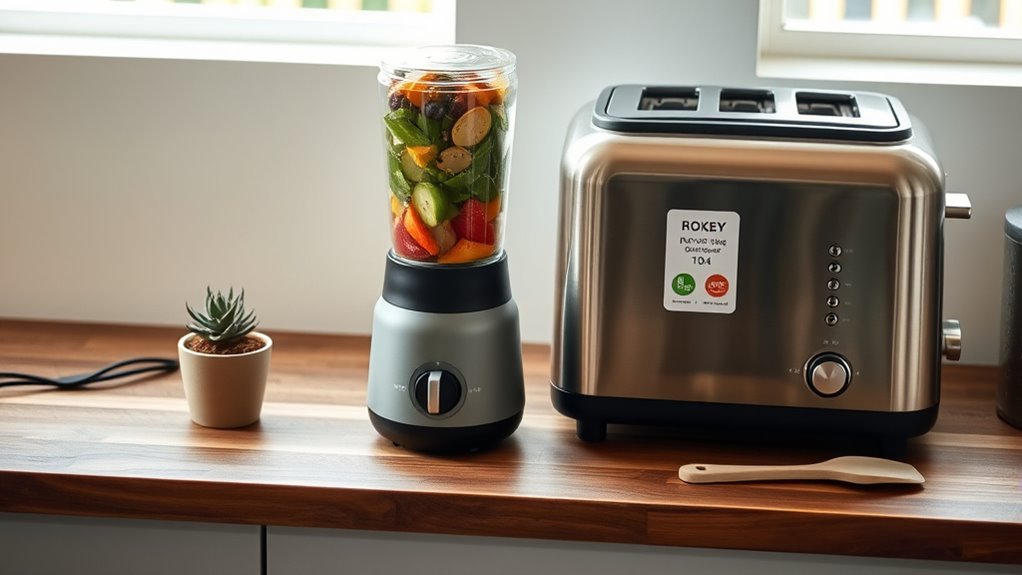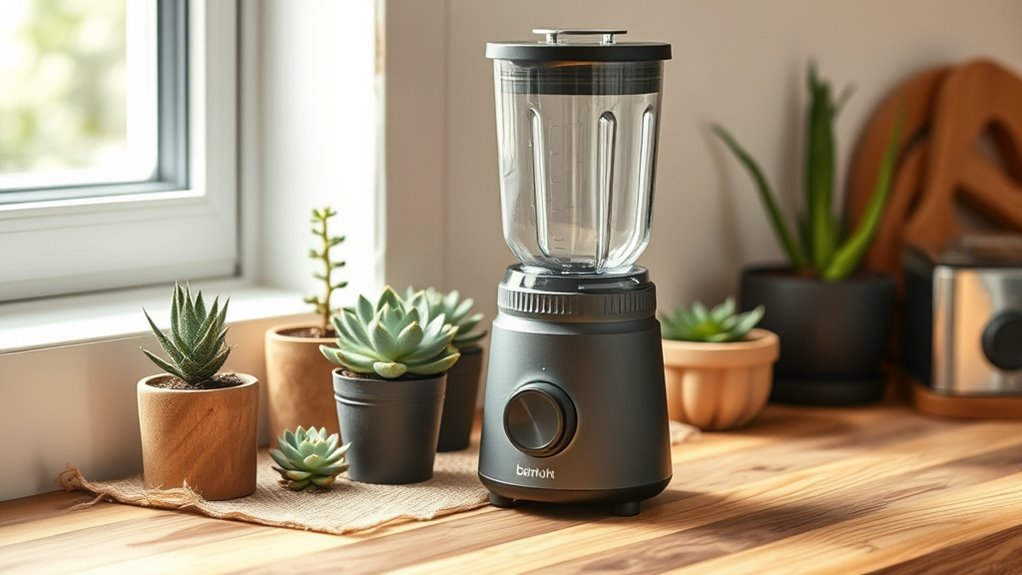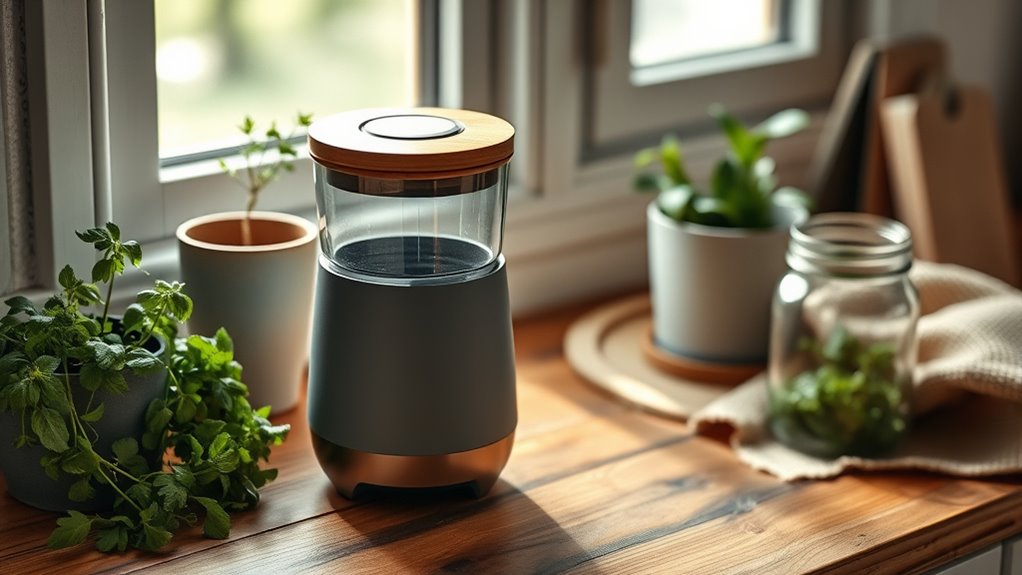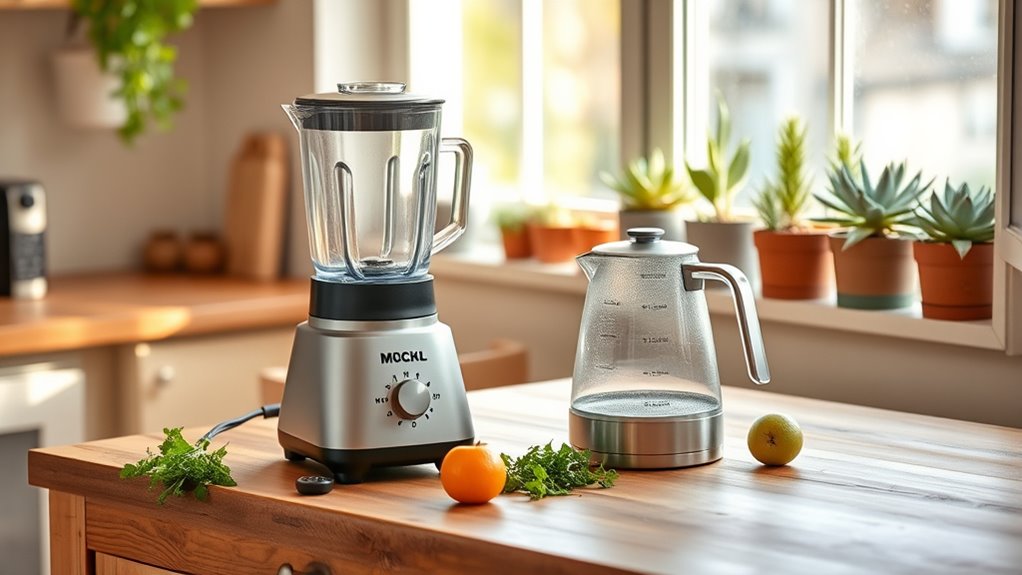When choosing eco-friendly small appliances, focus on energy efficiency ratings like ENERGY STAR, recyclable materials such as recycled plastics and metals, and sustainable design features. Look for products made with biodegradable or renewable materials like bamboo or reclaimed wood, and prioritize those with low water and power consumption. Regular maintenance and proper usage can extend their lifespan and boost eco benefits. Keep exploring to discover more tips on selecting and caring for sustainable appliances that fit your lifestyle.
Key Takeaways
- Prioritize appliances with ENERGY STAR certification to ensure energy efficiency and reduced environmental impact.
- Choose products made from recyclable or biodegradable materials like recycled plastics, metals, bamboo, or rattan.
- Look for devices with eco-friendly features such as low wattage, automatic shutoff, and water-saving functions.
- Regularly maintain and clean appliances to prolong lifespan and optimize energy and water usage.
- Support brands committed to sustainability through eco-conscious packaging and transparent environmental practices.
Understanding What Makes Small Appliances Eco-Friendly

Understanding what makes small appliances eco-friendly begins with examining their design and materials. You’ll find that eco-friendly appliances prioritize recyclable components, allowing you to reduce waste by repurposing or disposing of parts responsibly. These appliances often feature materials like recycled plastics or metals, which lessen environmental impact. Additionally, biodegradable packaging plays a vital role, as it breaks down naturally without polluting the environment. When selecting small appliances, look for products that use packaging made from biodegradable materials, signaling a commitment to sustainability from the manufacturer. By choosing appliances with recyclable components and biodegradable packaging, you actively support environmentally conscious practices and reduce your carbon footprint. These design choices demonstrate a genuine effort to make small appliances more sustainable and less harmful to the planet.
Key Features to Look for in Sustainable Appliances

When choosing eco-friendly appliances, you should focus on energy efficiency ratings to make certain you’re saving power and reducing your carbon footprint. Additionally, look for appliances made with eco-conscious materials that are sustainable and safe for the environment. These features help you make smarter, greener choices for your home. Ensuring proper installation and venting is also crucial for maintaining safety and efficiency in your eco-friendly appliances.
Energy Efficiency Ratings
Energy efficiency ratings are a crucial factor to take into account when choosing sustainable small appliances because they directly impact your household’s energy consumption and environmental footprint. Look for appliances with high energy ratings, which indicate better performance with less energy use. Efficiency standards set by organizations like ENERGY STAR help you identify products that meet strict criteria for energy savings and environmental responsibility. These standards ensure that the appliance operates effectively while minimizing power consumption. Selecting devices with superior efficiency ratings not only reduces your utility bills but also supports eco-friendly practices. Keep in mind that energy ratings are a dependable way to gauge an appliance’s sustainability and long-term cost-effectiveness, making them an essential consideration in your eco-conscious shopping. Additionally, evaluating the energy consumption data of appliances can provide further insights into their environmental impact over time.
Eco-Conscious Material Choices
Choosing appliances with eco-conscious materials enhances your efforts to reduce environmental impact. Look for products made from biodegradable plastics, which break down naturally and lessen landfill waste. Recycled metal usage also signals sustainable choices, as it reduces mining and energy consumption. When selecting appliances, prioritize those built with these materials to ensure durability and eco-friendliness. Here’s a quick guide:
| Material Type | Benefits | Examples |
|---|---|---|
| Biodegradable plastics | Breaks down naturally, reduces waste | Kitchen gadgets, casings |
| Recycled metal usage | Saves energy, less mining | Small appliance frames |
| Sustainable composites | Durable, eco-friendly alternatives | Exterior panels |
| Reclaimed wood | Adds natural appeal, reduces deforestation | Handles, accents |
| Bamboo and rattan | Renewable, biodegradable options | Handles, trims |
Additionally, selecting appliances with eco-friendly manufacturing processes can further minimize environmental impact.
Top Eco-Friendly Small Appliances for Your Kitchen

Incorporating eco-friendly small appliances into your kitchen not only reduces your environmental impact but also saves you money in the long run. Some of the top options include appliances with eco label certifications, ensuring they meet sustainability standards. When choosing these appliances, look for models that support recycling programs for end-of-life disposal. Here are four appliances to ponder:
- Compostable coffee makers – use biodegradable pods and energy-efficient features.
- Smart toasters – with automatic shutoff and energy-saving modes.
- Energy-efficient blenders – with low wattage and durable, recyclable parts.
- Eco-friendly rice cookers – designed for minimal power consumption and recyclable components.
Additionally, selecting appliances with energy-saving features can further enhance your eco-friendly efforts. These options help you support sustainability while maintaining a functional, eco-conscious kitchen.
Choosing Energy-Efficient Laundry Solutions

Since laundry accounts for a substantial portion of household energy use, selecting efficient solutions can make a meaningful difference. To reduce energy consumption, choose ENERGY STAR® certified washers and dryers, which use less power and water. Front-loading machines are generally more efficient and gentler on the appliance lifespan, helping your appliances last longer. Opt for high-efficiency settings and avoid overloading your washer to maximize energy savings. Using cold water cycles also cuts energy use considerably, since heating water consumes most of the energy in laundry. Regular maintenance, like cleaning filters and checking seals, keeps appliances running efficiently. Incorporating wall organization systems with your laundry area can also enhance space efficiency and keep the environment tidy. By making these choices, you not only cut costs but also extend the lifespan of your laundry appliances, contributing to a more sustainable home.
Water-Saving Devices for Everyday Use

Implementing water-saving devices in your home can substantially reduce overall water consumption and lower utility bills. These devices support water conservation efforts and can be powered sustainably with solar power systems. To maximize efficiency, consider:
- Low-flow showerheads that reduce water use without sacrificing pressure.
- Faucet aerators that minimize flow while maintaining performance.
- Dual-flush toilets that give you options for liquid and solid waste.
- Sensor-activated taps that prevent unnecessary water flow.
Understanding core personality traits can also help you select the most suitable devices for your household needs.
Materials and Design: Prioritizing Sustainability

Choosing sustainable materials and thoughtful designs is essential when creating eco-friendly small appliances. You should opt for biodegradable plastics that break down naturally, reducing environmental impact after disposal. Using renewable materials like bamboo, recycled metals, and sustainably sourced wood minimizes reliance on finite resources and supports eco-conscious production. Prioritize designs that are simple, durable, and easy to repair, which extends the appliance’s lifespan and decreases waste. Incorporating modular components allows for easier upgrades and replacements, further reducing environmental footprint. When selecting materials, consider their lifecycle, from sourcing to disposal, ensuring they contribute to sustainability goals. Automation technology can also enhance the manufacturing process by improving efficiency and reducing waste. Thoughtful design, combined with eco-friendly materials, helps you create appliances that are not only functional but also kinder to the planet.
Tips for Maintaining and Extending Appliance Lifespan

To keep your small appliances running smoothly, regular cleaning is essential. Proper storage also helps prevent damage and prolongs their life. By following these simple tips, you can maximize their efficiency and eco-friendliness for years to come. Additionally, ensuring that your appliances are used within their recommended specifications helps maintain optimal performance and extends their lifespan.
Regular Cleaning Practices
Regular cleaning is essential for keeping your small appliances functioning efficiently and extending their lifespan. Developing consistent cleaning routines supports appliance maintenance and prevents buildup that can cause malfunctions. To maximize effectiveness, consider these steps:
- Unplug the appliance before cleaning to ensure safety.
- Use non-abrasive cleaners suited for the appliance’s materials.
- Wipe surfaces and removable parts regularly to prevent residue buildup.
- Pay special attention to vents and filters, cleaning them as recommended by the manufacturer.
Proper Storage Techniques
Proper storage is essential for maintaining your small appliances and extending their lifespan. To achieve this, focus on good appliance organization by designating specific spots for each device. Use storage containers to keep cords, accessories, and manuals tidy and protected from dust and moisture. Before storing, make sure your appliances are completely dry to prevent mold or corrosion. Avoid stacking heavy items on top of delicate parts, which could cause damage. When not in use, store appliances in a cool, dry place away from direct sunlight, which can degrade plastic components. Incorporating proper organization practices can help prevent accidental damage and reduce clutter, making it easier to find and use your eco-friendly appliances when needed. Well-organized storage extends their functionality and lifespan, supporting your sustainability goals.
Incorporating Eco-Friendly Appliances Into Your Routine

Switching to eco-friendly small appliances is a straightforward way to reduce your environmental impact. To incorporate them into your routine effectively, consider these steps: 1. Choose appliances with eco label certifications, ensuring they meet sustainability standards. 2. Participate in local recycling programs to dispose of old appliances responsibly. 3. Use appliances efficiently by avoiding unnecessary operation and maintaining them properly. 4. Opt for multi-functional devices to minimize energy consumption and clutter. Additionally, practicing creative problem-solving can help you find innovative ways to integrate sustainable appliances into your daily life more effectively.
The Impact of Using Sustainable Small Appliances

Choosing eco-friendly small appliances doesn’t just benefit the environment; it also substantially impacts your energy consumption and household costs. Using sustainable appliances reduces your carbon footprint and enhances your eco impact. When appliances consume less energy, you lower greenhouse gas emissions, helping fight climate change. Additionally, you save money on utility bills over time. Here’s a quick comparison:
| Traditional Appliance | Sustainable Appliance |
|---|---|
| Higher energy use | Lower energy use |
| Larger carbon footprint | Smaller eco impact |
| Higher utility costs | Reduced household costs |
| Shorter lifespan | Longer durability |
Being aware of the energy efficiency of your appliances can further help you make informed sustainable choices.
Frequently Asked Questions
How Do Eco-Friendly Appliances Compare in Cost to Traditional Options?
You might wonder how eco-friendly appliances compare in cost to traditional ones. Generally, they have a higher initial investment, but you save money over time through energy savings. These appliances use less power and water, reducing your utility bills. Though the upfront cost is higher, the long-term savings and environmental benefits often make eco-friendly options a smart, cost-effective choice for your home.
Are There Certifications to Verify an Appliance’S Sustainability Claims?
While some claims might seem overly optimistic, you should look for trusted eco labels and certification standards to verify sustainability. These certifications act like a friendly compass, guiding you through the many options. They guarantee the appliance meets strict environmental criteria, giving you confidence in its eco-friendliness. Always check for reputable certification standards, so you can enjoy your purchase knowing it aligns with your values and supports a greener future.
Can Small Appliances Be Recycled or Repurposed at End-Of-Life?
You can definitely recycle or repurpose small appliances at end-of-life. Many recycling programs accept appliances, breaking them down to recover valuable materials like metals and plastics. Additionally, you can explore repurposing options—turning old appliances into art, planters, or storage solutions. Check local recycling centers or community programs to guarantee proper disposal, and get creative with repurposing projects to extend your appliance’s usefulness and reduce waste.
Do Eco-Friendly Appliances Perform as Well as Conventional Ones?
Think of eco-friendly appliances as reliable teammates, ready to perform just as well as conventional ones. You’ll find they excel in energy efficiency, helping you save on bills, and often boast improved durability. While some might worry about performance, many sustainable options are built to match or even surpass traditional appliances. So, you don’t have to sacrifice quality for your eco-conscious choices—these appliances stand strong and ready to meet your needs.
How Do I Determine the True Environmental Impact of a Small Appliance?
To determine the true environmental impact of a small appliance, you should look at its carbon footprint and energy efficiency. Check the energy labels and certifications, such as ENERGY STAR, to see how much energy it consumes. Also, research the materials used and manufacturing practices. By comparing these factors, you can choose appliances that minimize environmental harm and fit your sustainability goals.
Conclusion
Switching to eco-friendly small appliances isn’t just about saving the environment—it’s about saving money and enhancing your daily life. While these sustainable options might seem small, their impact adds up, proving that conscious choices create big change. So, next time you choose a gadget, remember: it’s not just an appliance, it’s a step toward a greener future. The power to make a difference is in your hands—small choices, lasting impact.









